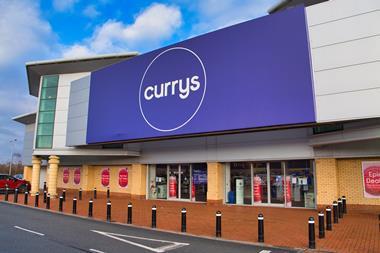Every second that stock is sat in your business costs you money. So, with the clock ticking, the aim of the game is to get products to the point where you can sell them as quickly and cost effectively as possible.
Even with tough trading conditions, supply chain technology is essential to ensure the smooth flow of goods; and even better if it can optimise this flow.
Marks & Spencer announced last week that it will open a distribution centre specifically for its Direct business. Other retailers have also been busy setting up staging posts for their international supply chains, as growth attention turns to franchises and other overseas sales activity.
Morrisons is also thought to be introducing an automatic ordering system for slow moving lines. The idea is to make its ordering process more efficient and improve availability, while allowing order decision making to be focused on faster moving lines.
Aldata UK managing director Mark Croxton believes that retailers are looking again at the efficiency of their inventory. In particular, Musgrave is introducing store replenishment applications and Midlands Co-op is implementing an inventory management system. Croxton explains: “Midlands Co-op implemented end-to-end retail systems to give it visibility of its point of sale.
In the food sector, spend is protected, though behaviour is different, and customers are being selective about what they buy.” He says that this requires fast reaction times to what is happening at stores, especially around promotions.
The inventory management system is live in pilot stores and will roll out next year. He explains: “We are putting in a wide suite of applications that together give great visibility and allows Midlands Co-op to make sure stores are compliant with pricing and promotions, etc.”
Not all projects will be on a grand scale. Low-risk initiatives to add functionality to existing systems can bring quick – and cheap – wins.
For instance, Croxton adds that retailers are doing more deals with suppliers – including not paying suppliers until they have sold the stock. If you can’t manage these complex deals through your systems then you end up with lots of invoice queries, which brings added systems requirements.
Call and response
Lots of retailers have rolled out voice-directed order picking in their distribution centres in the past few years and have achieved big efficiency gains when the systems went live. Now they are looking again at how they can take further advantage of this technology.
WHSmith distribution centre general manager Jim McCafferty says the company deployed voice picking in its travel division three and a half years ago, but it is still making enhancements and getting additional benefits.
The retailer has also rolled out a new generation of wearable computers running the Vocollect Voice software working with VoiteQ. McCafferty says: “After having the system for a number of years the travel division has grown enormously – the store numbers have doubled – and we have had to enhance our current system from the Talkman T2 units to Talkman T5 units.”
He explains that they are far quicker and allow management to provide prompts to staff, as well as producing more productivity information.
When the company first introduced voice technology productivity improved 15 to 20 per cent and these benefits have continued. “Since we have introduced the system we have grown hugely and have been able to keep the pence per unit cost exactly the same as it was six years ago, despite wage inflation. That’s why we have enhanced the system,” he says.
McCafferty adds: “It gives us real-time visibility of replenishment, which enables us to be far quicker. We are better able to respond to replenishment requests. Our service levels are so much better that we don’t need to employ a quality control person.”
The same system has been deployed in different areas of the warehouse, with subtle differences to match the type of stock in question. There are three main picking areas, each with their own unique processes, such as for confectionery and drinks, or books. WHSmith staff can use each of the terminals anywhere and just have to tell the unit which zone they are in to get the relevant interface.
McCafferty says the company isn’t finished with its deployment plans either. “We are looking at introducing the system to our dispatch area to confirm deliveries into trucks.” He says there could be huge benefits if the system is extended in this way to track and trace containers of products on to vehicles.
Meanwhile, at Ted Baker additional development on existing systems is also bringing new benefits without costing the earth.
Ted Baker IT manager Dustan Steer explains that the retailer has been piloting a portal for wholesale partners since August. A couple of the larger department stores it trades with, as well as some smaller independents, are trialling the system, which is designed to make repeat ordering easier.
Steer explains that Ted Baker is able to use the existing functionality in its Prologic software to run the portal, with only slight amendments to make it fit for purpose. Users receive a log-in to the portal, which connects directly to Ted Baker’s database and acts as a front end for the main ordering system.
He adds that partners will always be invited in to view new collections and place initial orders, but this makes the reordering process more simple. The plan is to give all of Ted Baker’s partners – including international ones – the option of using the system in the future, once feedback from the pilot has been taken in and any necessary changes made to the way the portal works.
Fuel for thought
Supermarkets, including Tesco and Asda, have also expanded their use of transport routing and optimisation systems in the past year. Though the price of fuel has been falling for the past few weeks at retailers’ own petrol pumps, the same cannot be said for the fuel they use in their supply chains.
Croxton says: “The other thing worrying retailers is fuel – they have negotiated their contracts for fuel for next year and there is double-digit inflation on those costs. They are taking a judgment call on what will happen to fuel costs. They may not get it right, but at least they will know where they are with their costs.”
This makes transport optimisation even more of a challenge for retailers, as they seek to ensure that trucks are full, taking optimal routes and where possible are also getting value from return journeys.
Another trend that has been seen in warehouse technology in the past few years is automation. It cuts down on the pairs of hands that must touch products within the warehouse and can improve speed and efficiency. But Croxton says that it will not be an investment priority for all at the moment.
He explains: “Automation is expensive to put in and it can create inflexibility within the supply chain unless the retailer is certain of what’s going on and its volumes.” He adds that downward pressure on wages could also mean that retailers are worrying a little less about these costs.
In the US, a few retailers are now taking the idea of automation to the extreme. Online shoe retailer Zappos.com rolled out a mobile fulfilment system earlier this year in just four months to support rapid order growth and an expansion into new categories such as sportswear.
It is using a fleet of Kiva Systems’ mobile robots and inventory storage pods, meaning stock can be moved around within its distribution centre without needing staff or conveyors to transport it.
While UK retailers might not be ready for this level of technology, there is another reason that investment in supply chains and systems decisions might be reviewed.
The market has seen much consolidation and the plight of many retailers and their financial backers at present means that more mergers and acquisitions seem likely. Croxton believes retailers that buy others will have supply chains high on the list of areas where synergies can be identified and costs cut. So those involved in these deals will have to reconsider how they run and support their supply chains.
During trading conditions like those being experienced today, the last thing that retailers need is empty shelves, sellable stock sat in warehouses, or delayed home deliveries. Modern and agile supply chain systems are critical if retailers are to maximise their potential.


























No comments yet